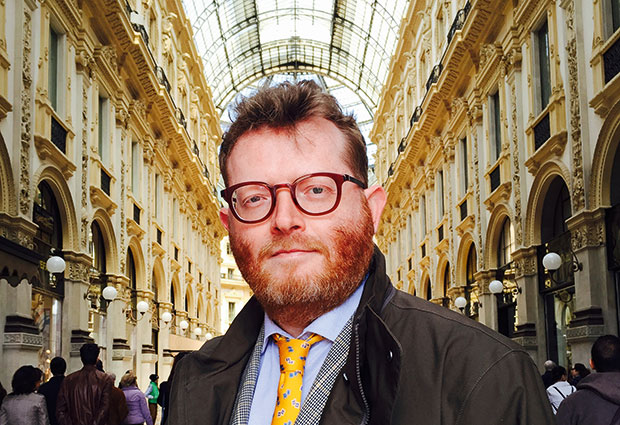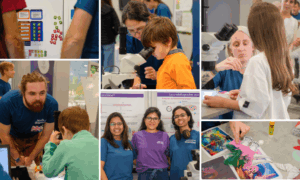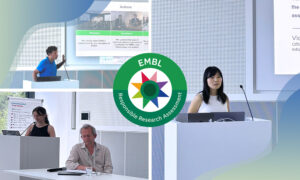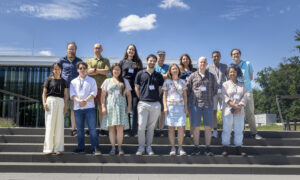
Digitally human: texting life ahead
Alumnus Giuseppe Testa reflects on the myriad intersections of our digital and biological lives, in the third and last article in our Human minds series on the social and scientific implications of studying human biology.

By Giuseppe Testa
This tweet I received from the Genentech account as a celebration of DNA day in 2014 exemplifies the conflation of the digital and the living that defines our times: life out of sequence, in the poignant title of a recent book on the emergence of bioinformatics.
The sheer possibility that our genome be computed in Twitter’s metric is rooted of course in the fact that both are texts. Twitter, like many other instances of our digitised sociality, is literally a universe of texts. The genome, while literally enmeshed in the all too fleshy chemical complexity of chromatin, can nonetheless be productively understood as text. But there is more than the alignment of two textualities that emerges from this tweet. For it is not only that we make sense of the genome as text; it is the entire edifice of molecular biology, and indeed the whole enterprise of providing a molecular understanding of life, that is predicated on a genome-compatible, textual gaze that parses living phenomena in digital format. Indeed, the expansion of the life sciences into the fabric of our time is rooted in the eminent flexibility of its technological core, which entails at its most basic the following two capacities: i) that of encompassing an increasing range of biological objects and functions in digital format; and ii) that of intervening into biological objects and functions by harnessing their digital codes through a panoply of molecular switches.
Digitising ambition
Let us think, as an example, of our reframing of cell identity as a problem of combinatorial usage of enhancers, which we can now rewire through Crispr/Cas9-based epigenetic editing, a word that once more reminds us of the digital cycle of reading – and rewriting – life as text. Or let us contemplate the spectacular developments of cell reprogramming, in which cell fate is re-inscribed, inside or outside our body, through the combinatorial usage of few transcription factors, a digitisation of cell fate poised to intersect the equally momentous digitisation of materials and shapes, all the way to the prospect of 3D organ printing. From molecules to ‘omic’ profiles, from cellular lineages to organs, from organisms to environments, all more or less classically defined levels of biological organisation are now amenable to the digitising ambition of the contemporary life sciences.
Quite literally, we are even redefining space and shapes through sequencing: think only of the various technologies used to probe the three-dimensional structure of the nucleus in terms of proximity of DNA stretches; or, at the other end of the spectrum, of recent successes in redefining tissue architectures and identities through the multiplexed interrogation of their single cells’ transcriptomes. And even those aspects of our life that extend far beyond the sequencing of biomolecules, from medical records to credit card balances, from fMRI scans to Whatsapp conversations, are anyway all captured in digital format and hence ready to be overlayed onto the fully textualised exposition of our inner workings.
The genome has become much more than a critical developmental resource
As both practicing molecular biologist and scholar in science and technology studies, I find this digital juncture particularly salient. We recently argued that scientific and social reconfigurations around the life sciences are to do with the newly found visibility they afford, with the parsing of the human condition through new units of sense-making that render it both increasingly transparent and naked: transparent, through the progressively deepening impact of our molecular gaze; and naked, once that gaze has exposed new vistas that demand choices and thereby interrogate our individual and collective sense and sensibility. The next step is to realise that this molecular visibility of our selves comes in digital format, and to probe the full implications of this turn. For there is a virtually ubiquitous talk of ‘big data’. Yet what has gone unnoticed so far is how seamlessly the digital representation of our selves that emerges from the life sciences can be integrated with the other digital worlds of our times. Indeed, as we recently showed, the rise of epigenetics is largely predicated on the promise to overlay ‘what seemed irreducibly analogic (the social, the environmental, the biographical, the idiosyncratically human)….onto the digital genome of the informationally ripe age’, with epigenomic profiles providing ‘the new place holders to anchor the environment to the genome and enable the attending analogic–digital translations, conceptually as much as experimentally’.
Layers of humanness
The genome has thus become much more than a critical developmental resource. In its textual representation, it has taken on the role of a lingua franca, the eminently versatile digital scaffold onto which the layers of our humanness can be superimposed at distinct yet compatible levels of inquiry. The flexibility of this scaffold, of the digital core that propels the life sciences manifests itself first and foremost in the explosion of questions and contexts to which it is being applied. From mental illness to environmental pollution, from ageing to diet, from cancer to poverty, virtually all aspects of society’s wellbeing are becoming amenable to biological inquiry through a multi-scale approach that illuminates these phenomena at distinct but compatible levels of analysis.
Accordingly, our identity is also increasingly distributed and fragmented, each of us projected into an expanding repertoire of objects or representations that capture slices of our human condition with all too tangible an impact: genomes, collections of phenotypic and lifestyle information from various sources, cells and gametes stored in biobanks, avatars of our healthy and diseased tissues. And each of them often inhabits quite distinct regulatory spaces, projections (but also sources) of our selves that are invested with different legal and political meaning. The challenge is thus remarkable: to navigate the spectacular amplification of our digitised biologies governing our increasingly distributed self, and developing the necessary resources – individual and institutional alike –, to control the overlay of our manifold ‘twittomes’ onto our genome.


